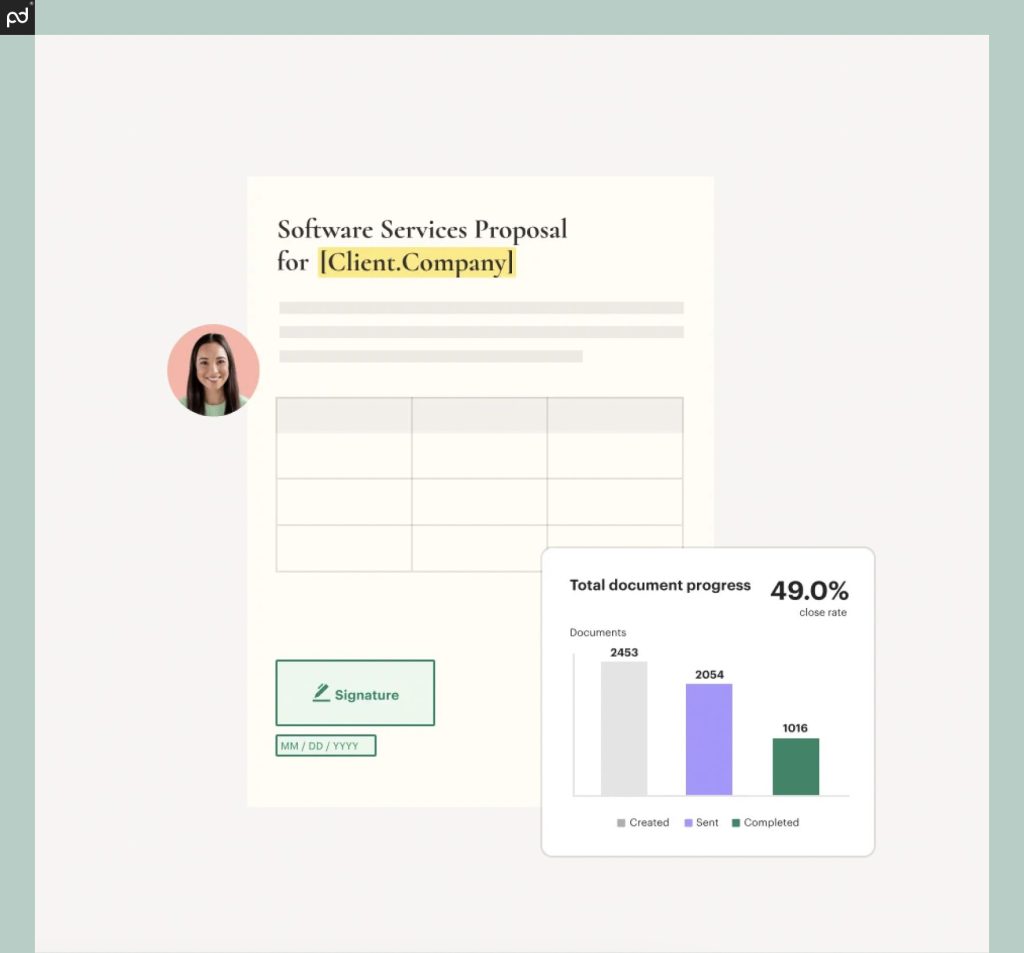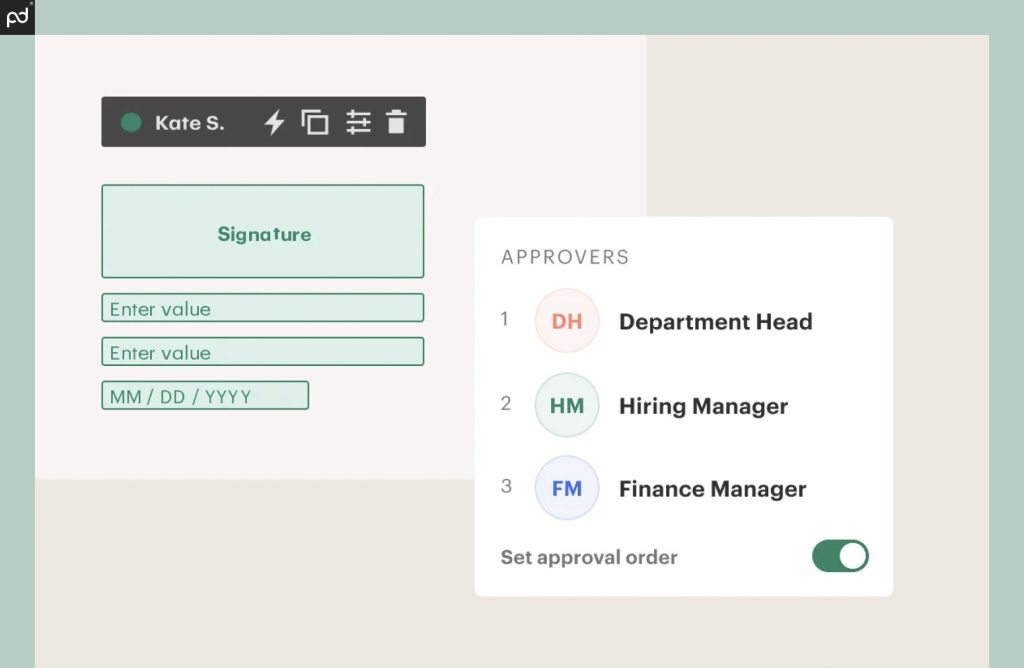The COVID pandemic forced many things to be done remotely, and even the healthcare industry — famous for adopting admin change at a glacial pace, if at all — had to adjust to a new normal.
Yet, as anyone working in the healthcare sector can tell you, there is still a long way to go.
According to the 2023 CAQH Index, administrative complexity is responsible for about 10% ($400 billion) of the total national healthcare expenditures in the US.
We believe many such time-consuming and expensive administrative side effects can be addressed through document management automation powered by electronic signatures.
In this article, we’ll explain how covered entities can better adapt to this new reality, and provide examples of healthcare companies using e-signatures to streamline all business processes.
Key takeaways
- An electronic signature policy for medical records helps solve the precision, security, and compliance challenges of traditional handwritten signatures, driving benefits like decreased proposal preparation time, minimized human error, reduced identity theft risks, and full HIPAA compliance.
- Although HIPAA doesn’t explicitly promote electronic signatures, it provides an array of requirements, among which are audit controls, robust authentication and access management mechanisms, non-repudiation, legal compliance with state laws, and in-house policy implementation.
- Document automation covers use cases such as client data management, administrative tasks, back office operations, and optimizing time spent by marketing and sales teams.
- Sales representatives leverage document management and electronic signing capabilities to automate the creation of contracts, proposals, and quotes, which helps them improve sales processes, build firm customer relationships, and propel their medical services in the healthcare market.
Benefits of electronic signing for healthcare organizations
Electronic signatures address the key precision, security, and compliance concerns of traditional handwritten signatures, bringing healthcare companies tangible value.
Improved efficiency
Document management software and smooth integrations with CRM and other customer-related systems help covered entities notably decrease the time needed for preparing and creating proposals, consent forms, contracts, quotes, and marketing reports.
Sales representatives are spared manual, tedious work and can pay more attention to strengthening customer relationships.
Utmost accuracy
By adopting an electronic signature policy for medical records, covered entities use smart, fillable fields to ensure all submitted information is legible and complete.
Additionally, utilizing an audit trail feature allows healthcare companies to monitor every action taken with the document, reducing human error and tracking when it was viewed and edited.
Security
Underpinned by encryption, authentication, and audit trail capabilities, electronic signatures ensure that only fully authorized users can access patient or customer records at an agreed-upon time and date.
Doing so ensures document legality, information non-repudiation, message integrity, and reduces the risk of identity theft.
Regulatory compliance
Digital signing presupposes that each completed document comes with a certificate of authenticity.
Electronic PHI (ePHI) is safeguarded under the HIPAA security rule that establishes security, availability, integrity, confidentiality, and privacy industry standards.
What are the HIPAA e-signature requirements?
Although the HIPAA privacy act doesn’t explicitly mention (endorse or prohibit) e-sign technology, this US federal law provides specific electronic signature requirements and considerations:
- Authentication and access control. Covered entities should ensure the confidentiality and integrity of the signed electronic medical records by implementing technical safeguards. Specifically, authentication mechanisms and access controls have to limit signature capabilities to properly authorized users.
- Audit controls should be implemented to track all signature events, including the signer’s identity and any changes made to the signed document.
- Non-repudiation means the signer can’t deny having signed the electronic documents.
- Legal compliance. Electronic signature solutions must comply with state and federal laws, such as the Uniform Electronic Transactions Act (UETA) and the Federal Electronic Signatures in Global and National Commerce Act (E-SIGN Act).
- In-house policies should be implemented in covered entities to govern the use of e-signatures.
Applications of electronic signatures in various healthcare sectors
Healthcare companies heavily rely on medical records, and the proper application of e-signatures improves key workflows and promotes value-based care.
Patient information management
This includes using digital signing to obtain patient consent to medical procedures, treatment plans, or the release of ePHI.
The signed documents are stored securely in EHR systems for future reference, decreasing administrative burdens.
With e-signatures, healthcare companies can also speed up pharmacy transactions (including vendor deliveries, distribution of medications, and dispensation) and prescription signing (so that patients could receive the drugs as soon as possible).
A case in point
TheKey, a leading U.S. in-home care provider with 110 corporate offices across 31 states, teamed up with PandaDoc to improve their document management.
By switching from DocuSign to PandaDoc, the company saved 3,000 hours annually and clinched 10x efficiency in handling consent agreements.
We covered the client’s large-scale documentation needs, propelling the integration of ten departments and streamlining document processes for over 8,000 caregivers and 1,500 corporate employees.
Document management
Automation around document creation, management, and signing allows healthcare companies to step up from Excel and PDFs that are too complex and/or lengthy at the time of getting a quote out to a customer.
In other words, sales and customer success teams can concentrate more on building customer relationships and less on paperwork.
A case in point
Werfen, a global leader in hemostasis, acute care diagnostics, and autoimmunity, approached PandaDoc with document management problems:
- Their sales team manually filled out 12 fields, from client information and product names, to pricing and expiration dates. This led to confusion between sales reps, including getting locked out of files when they urgently needed the documents.
- The Word templates they used lacked branding, and multiple versions of documents were presented to prospects and customers.
- Werfen’s Quarterly Business Reviews (QBRs) lacked consistency in terms of structure and information presented in the document.
PandaDoc helped the client decrease document preparation time from an hour to just 5 minutes and ensure consistency among different document types.
Although sales quotes were the primary use case, Werfen leveraged the flexibility and content-rich functionality of PandaDoc to extend its value to proposals and business reviews.
Marketing and sales management
Modern document management solutions enable the creation and customization of proposals, contracts, and quotes in minutes.
InSynch Healthcare Solutions, a leading provider of integrated EMR and practice management software, managed to save up to 50% of time with PandaDoc.
A smooth integration with HubSpot CRM empowered their sales representatives to build accurate documents auto-populated with pricing and client data.
And customized forms were key in obtaining valuable background information from customers through more detailed and standardized questions, which resulted in more successful discovery calls.

A case in point
The adoption of PandaDoc allowed Interlace Health to cut their proposal creation time by 85% through ready-to-use templates.
Electronic signing features and integration with Salesforce enabled better collaboration on specific proposals, sparing the sales team the need for back and forth emails.
The audit trail feature enhanced proposals approval, and the built-in legally-binding e-signatures significantly contributed to closing success, with 100% in signature and initial completions from the client’s prospects and customers.

Back-office automation
By eliminating manual approvals between colleagues and departments, you can enhance your strategic outreach and communications for attracting and engaging more healthcare consumers.
Electronic signatures can be used in HR departments to sign personnel-related documents, including contracts, onboarding notes, offer letters, and training materials.

Medical billing and insurance claims. The use of e-signatures for insurance claims and invoices can accelerate the reimbursement process and minimize errors through easier document access and search.
A case in point
Falck Ambulance, a global leader with over 3,000 ambulance and patient transportation vehicles in 26 countries, leveraged PandaDoc to revamp their billing process.
Typically, the company could wait up to nine months for patient information, and some clients never even sent out the bills at all.
This inefficiency resulted in 1,000 to 2,000 monthly forms being returned.
PandaDoc digitized the process of creating and filling out patient forms, which allowed them to bill Medicare providers much faster.
As a result, Falck Ambulance managed to shorten their billing cycle by six months — and do so at a much lower cost.
Implement electronic signatures in your healthcare business processes
We’ve covered how e-signatures go firmly hand in hand with document management automation.
Whether it’s patient consent signing, proposal creation, or monthly marketing report generation, the adoption of this tech allows covered entities to accelerate and improve their workflows.
PandaDoc offers an all-in-one solution for such purposes.
The platform’s signing feature is increasingly popular within the healthcare industry, with 2,051 monthly users.


